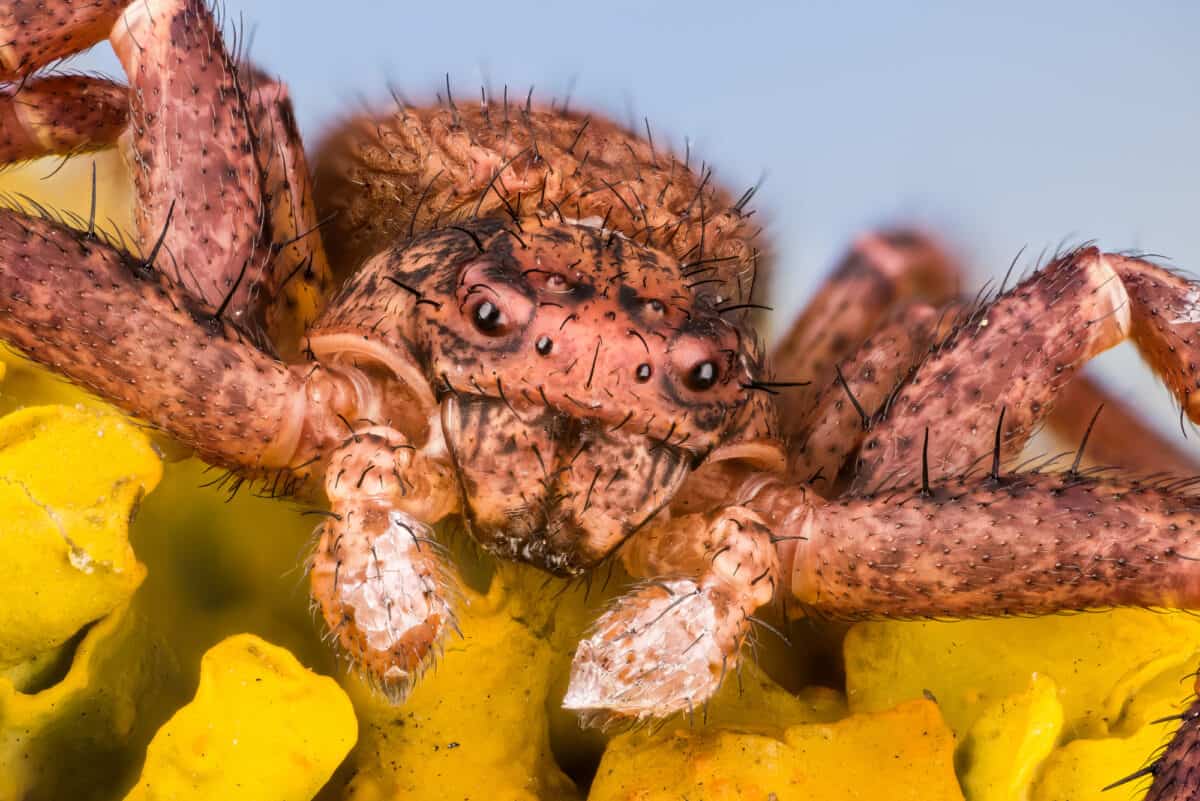The ocean’s depths harbor some of the most magnificent creatures on Earth, many of which defy our expectations with their enormous size. While whales and sharks might immediately come to mind when thinking of large marine animals, the underwater world is home to many surprising giants that often go unnoticed or unappreciated. From colossal invertebrates to massive fish species that have evolved to incredible proportions, these unexpected leviathans demonstrate the ocean’s capacity to nurture extraordinary life forms. This article explores 14 remarkable underwater giants that showcase the diversity and wonder of marine life, revealing creatures that might astonish even seasoned ocean enthusiasts with their impressive dimensions and unique adaptations.
14. Giant Squid (Architeuthis dux)

When discussing unexpected underwater giants, the giant squid deserves top billing. These elusive cephalopods can reach lengths of up to 43 feet (13 meters), including their tentacles, making them one of the largest invertebrates on Earth. Despite their massive size, giant squids remained largely in the realm of myth until the early 2000s, when they were finally photographed alive in their natural habitat. Their enormous eyes—nearly the size of dinner plates at up to 10 inches (25 cm) in diameter—are the largest in the animal kingdom, allowing them to detect the faintest light in the deep ocean’s darkness. These creatures inhabit depths between 1,000 and 3,000 feet (300-900 meters), where they hunt fish and other squid species using their two long feeding tentacles equipped with toothed suction cups to capture prey.
13. Japanese Spider Crab (Macrocheira kaempferi)

Looking more like an alien creature than an earthly inhabitant, the Japanese spider crab holds the record for the largest arthropod leg span—measuring up to 12 feet (3.7 meters) from claw to claw. Found in the waters off Japan, particularly around the Pacific side of the Japanese archipelago, these crustaceans can weigh up to 42 pounds (19 kg). Despite their intimidating appearance, Japanese spider crabs are primarily scavengers, feeding on dead animals and algae rather than actively hunting. They possess surprisingly long lifespans, potentially exceeding 100 years in ideal conditions. Their exoskeletons are often covered with small organisms like sponges and anemones, providing these giants with natural camouflage against predators during their younger, more vulnerable years.
12. Giant Pacific Octopus (Enteroctopus dofleini)
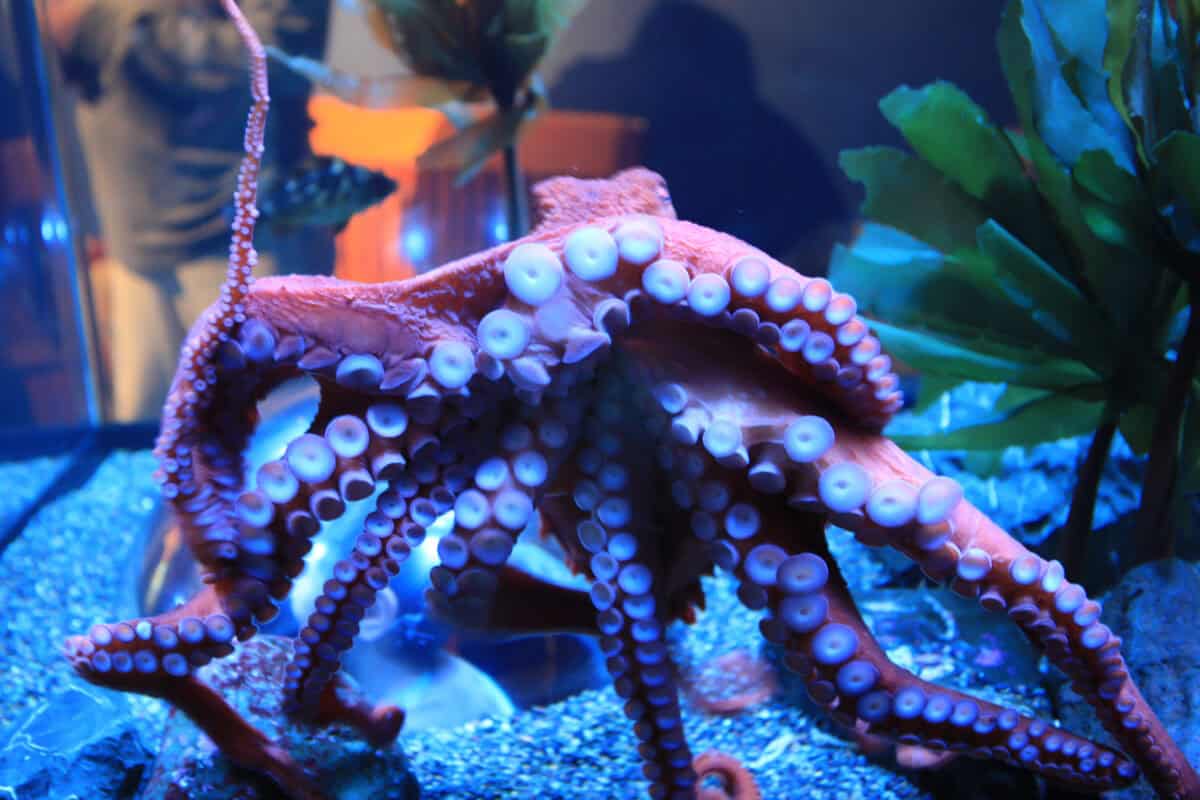
The giant Pacific octopus stands as the largest octopus species, with specimens reaching arm spans of up to 20 feet (6 meters) and weights exceeding 110 pounds (50 kg). Unlike many oceanic giants that achieve their size through longevity, these cephalopods pack this impressive growth into a tragically short lifespan of just 3-5 years. Native to the temperate waters of the North Pacific Ocean, they’re renowned for their remarkable intelligence, demonstrating problem-solving abilities, tool use, and even individual recognition of human handlers in captivity. Each giant Pacific octopus has approximately 2,000 suckers on its eight arms, with each sucker capable of independent movement and containing thousands of chemical receptors. These receptors effectively allow the octopus to “taste” whatever it touches, creating an extraordinarily complex sensory experience of the world around them.
11. Ocean Sunfish (Mola mola)

With its peculiar disc-shaped body, the ocean sunfish (Mola mola) appears more like a swimming head than a conventional fish. Despite this unusual appearance, it holds the title of the world’s heaviest bony fish, weighing up to 2.5 tons (2,268 kg) and reaching lengths of 14 feet (4.2 meters). Ocean sunfish undergo astonishing growth during their lifetime, with young fish increasing their weight by 60 million times from birth to adulthood. Their diet consists primarily of jellyfish, a surprisingly low-calorie food source that requires them to consume vast quantities to sustain their enormous bulk. These bizarre giants are often spotted basking on their sides at the ocean’s surface, a behavior that likely serves to warm their bodies after deep dives and allows seabirds to feed on parasites covering their skin—a natural cleaning service that benefits both species.
10. Giant Isopod (Bathynomus giganteus)

Resembling a roly-poly bug on steroids, the giant isopod is essentially a deep-sea pillbug that has evolved to monstrous proportions. Growing up to 16 inches (40 cm) long and weighing up to 3.7 pounds (1.7 kg), these crustaceans are approximately 2,000 times larger than their common terrestrial relatives. Giant isopods inhabit the cold, dark waters of the deep Atlantic, Pacific, and Indian Oceans at depths ranging from 550 to 7,020 feet (170-2,140 meters). Their enormous size is an example of deep-sea gigantism, a phenomenon where deep-ocean creatures evolve much larger bodies than their shallow-water counterparts. These remarkable scavengers can go remarkably long periods without food—one specimen at a Japanese aquarium famously survived five years without eating. Their prehistoric appearance and intimidating size make them among the most surprising creatures of the deep, despite being relatively closely related to the small isopods common in gardens worldwide.
9. Giant Oarfish (Regalecus glesne)

Often mistaken for sea serpents throughout history, the giant oarfish is the world’s longest bony fish, with confirmed specimens reaching up to 36 feet (11 meters) in length. Their ribbon-like bodies, topped with vibrant red dorsal fin crests and adorned with oar-shaped fins, have earned them their common name and contributed to many a sailor’s tale of sea monsters. These deep-sea dwelling fish typically inhabit depths between 660 and 3,280 feet (200-1,000 meters), making live sightings extremely rare. They propel themselves through the water by undulating their dorsal fin while keeping their body straight, creating a distinctive swimming pattern unlike most fish. Despite their imposing size, giant oarfish feed primarily on tiny krill, small crustaceans, and other zooplankton, which they strain from the water using their specialized gill rakers. When these enigmatic creatures appear in shallow waters or wash ashore, they typically do so because they’re ill or dying, leading to superstitions in some cultures that oarfish sightings predict earthquakes or tsunamis.
8. Lion’s Mane Jellyfish (Cyanea capillata)
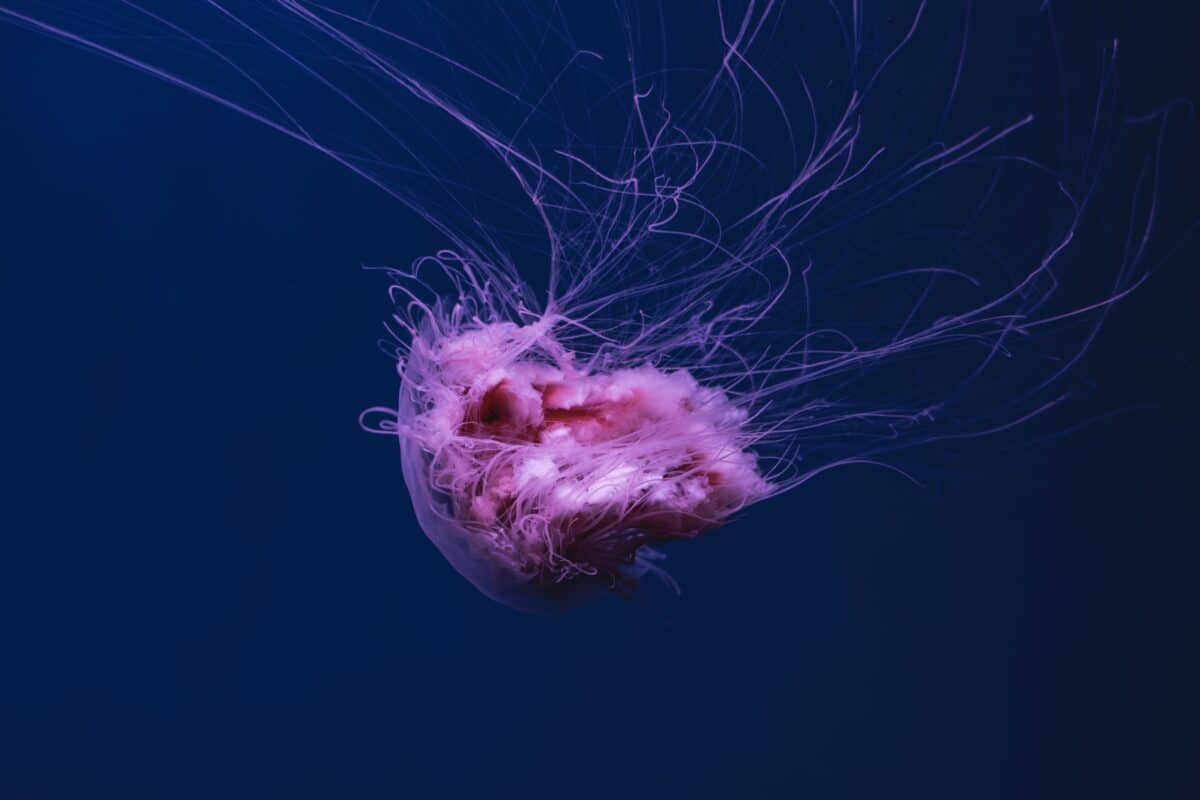
The lion’s mane jellyfish stands as the largest jellyfish species in the world, with specimens reaching bell diameters of over 7 feet (2.1 meters) and tentacles extending to a staggering 120 feet (36.6 meters)—longer than a blue whale. These gelatinous giants are found primarily in the cold waters of the Arctic, northern Atlantic, and northern Pacific Oceans. The name “lion’s mane” aptly describes their appearance, as their mass of thin, hair-like tentacles resembles the mane of a lion, typically displaying colors ranging from deep red to bright orange. Unlike many ocean giants that require years to reach full size, these jellyfish achieve their enormous proportions within just one year of life. Their tentacles contain powerful nematocysts (stinging cells) that they use to paralyze prey such as fish, smaller jellyfish, and plankton. While their sting can be painful to humans, it’s rarely fatal, though the enormous surface area covered by their tentacles makes encounters particularly hazardous for swimmers in waters where these giants reside.
7. Giant Grouper (Epinephelus lanceolatus)
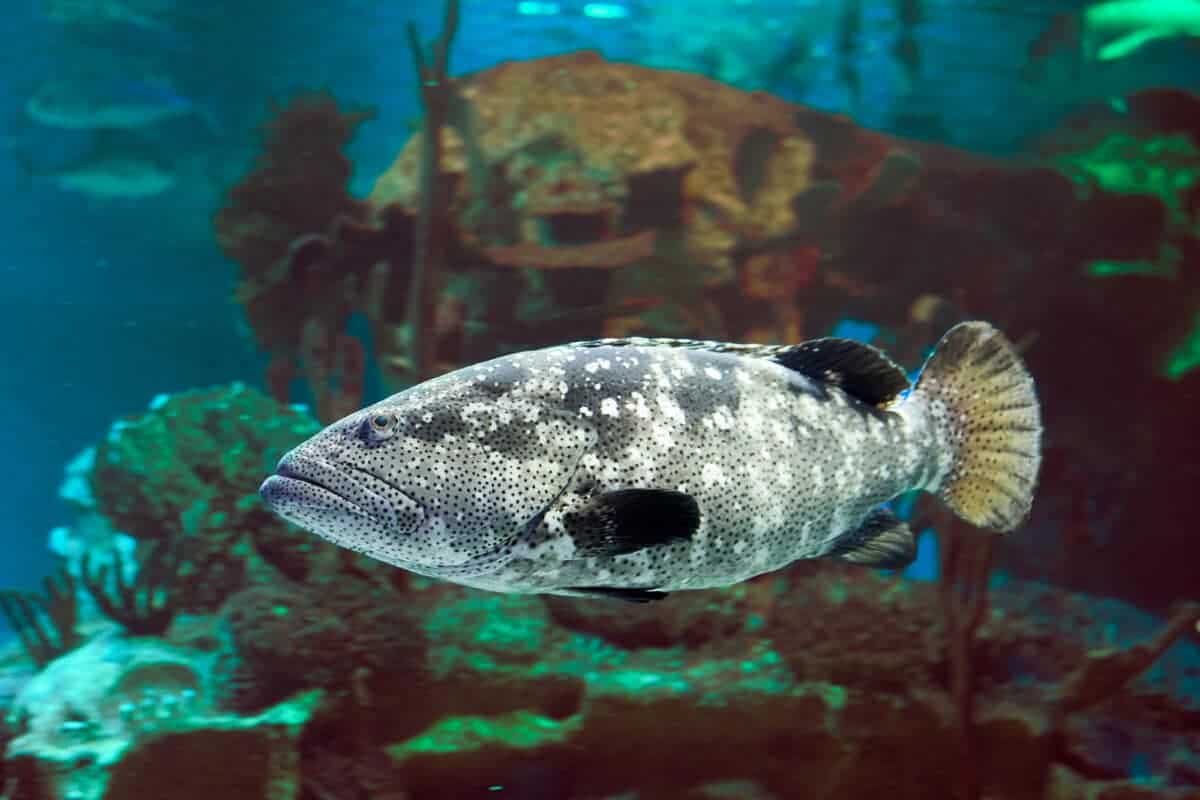
The giant grouper, also known as the Queensland grouper, is the largest bony fish found in coral reefs and can reach lengths of 8.8 feet (2.7 meters) and weights exceeding 880 pounds (400 kg). These colossal fish inhabit the Indo-Pacific region, from the Red Sea to the coral reefs of Australia and even the waters surrounding Hawaii. Giant groupers are ambush predators with mouths large enough to swallow prey whole, including small sharks, sea turtles, and even the occasional diving bird. They possess the remarkable ability to change their coloration to blend with their surroundings, despite their enormous size. These fish begin life as females and may transform into males as they age—a reproductive strategy known as protogynous hermaphroditism. Unfortunately, their slow growth rate, late sexual maturity, and territorial nature make them particularly vulnerable to overfishing, leading to their current classification as vulnerable by the International Union for Conservation of Nature (IUCN).
6. Giant Clam (Tridacna gigas)

Among the most unexpected giants of the ocean are the immense giant clams that can reach lengths exceeding 4 feet (1.2 meters) and weights of over 500 pounds (227 kg). These enormous mollusks live embedded in the coral reefs of the South Pacific and Indian Oceans, where they can live for more than 100 years. Unlike the predatory image perpetuated by cartoons and myths, giant clams don’t trap and eat divers; they’re actually filter feeders that obtain nutrients from the water and through a special symbiotic relationship with photosynthetic algae living in their colorful mantles. These algae provide the clam with supplementary nutrition through photosynthesis, allowing giant clams to grow to such impressive sizes despite limited food resources on the reef. The mantles of giant clams display a dazzling array of colors and patterns, including blues, greens, purples, and browns, creating what many consider to be among the most beautiful sights on coral reefs. Due to overharvesting for food, their shells, and the aquarium trade, giant clams are now listed as vulnerable to extinction.
5. Colossal Squid (Mesonychoteuthis hamiltoni)

While the giant squid may be longer, the colossal squid is significantly more massive, with specimens estimated to reach weights of up to 1,650 pounds (750 kg) and lengths of around 39-46 feet (12-14 meters). Native to the cold, deep waters of the Antarctic, this formidable cephalopod possesses the largest eyes ever recorded in the animal kingdom—measuring up to 11 inches (28 cm) in diameter and equipped with built-in light organs that help it detect prey in the darkness of the deep ocean. What truly sets the colossal squid apart are its unique tentacles armed with swiveling hooks and suckers ringed with sharp teeth, creating a devastating arsenal for capturing prey. These elusive giants primarily feed on Antarctic toothfish and are, in turn, a key food source for sperm whales, as evidenced by the numerous squid beaks found in whale stomachs. Despite their enormous size, very few specimens have ever been captured or observed intact, with most of our knowledge coming from partial remains found in the stomachs of predators or rare specimens brought up by deep-sea fishing vessels.
4. Goliath Tigerfish (Hydrocynus goliath)

The freshwater equivalent of a great white shark, the Goliath tigerfish lurks in the rivers and lakes of Central Africa, particularly the Congo River basin. Growing up to 5 feet (1.5 meters) long and weighing up to 154 pounds (70 kg), it’s the largest member of the tigerfish family and one of the most fearsome freshwater fish on the planet. What makes this fish particularly terrifying are its 32 razor-sharp teeth, each measuring up to one inch (2.5 cm) in length, which interlock perfectly when the jaw closes, allowing it to slice through prey with surgical precision. These aquatic predators have been documented taking down prey as large as young Nile crocodiles and have even been reported to attack humans occasionally. The Goliath tigerfish possesses exceptional speed and agility, capable of burst swimming that allows it to overtake almost any prey in its environment. Local fishermen treat these fish with extreme caution, as their powerful jaws can remain active even after death, potentially causing serious injuries to the unwary.
3. Giant Tube Worm (Riftia pachyptila)

Among the most alien-looking giants of the deep sea are the remarkable giant tube worms that grow around hydrothermal vents on the ocean floor. These extraordinary invertebrates can reach lengths of up to 8 feet (2.4 meters) and diameters of 2 inches (5 cm), making them among the largest worms on Earth. Unlike most animals that rely directly or indirectly on sunlight for energy, giant tube worms thrive in the complete darkness of the deep ocean by hosting chemosynthetic bacteria within their bodies. These bacteria convert toxic hydrogen sulfide from the hydrothermal vents into organic compounds that nourish the worm—a process called chemosynthesis. Perhaps most surprisingly, adult giant tube worms lack both mouths and digestive systems, relying entirely on their bacterial symbionts for nutrition. Their distinctive red plumes, which protrude from white tubes, contain specialized hemoglobin that can bind both oxygen and hydrogen sulfide, delivering these chemicals to the bacteria housed in an organ called the trophosome. These extraordinary creatures represent one of the most successful adaptations to the extreme conditions of deep-sea hydrothermal vents, environments once thought incapable of supporting complex life.
2. Giant Sea Cucumber (Thelenota anax)

Resembling massive marine slugs, giant sea cucumbers can reach lengths of up to 6.6 feet (2 meters) and weigh as much as 13 pounds (6 kg). These enormous echinoderms inhabit the tropical waters of the Indo-Pacific, where they slowly patrol sandy areas of coral reefs and lagoons. Despite their somewhat unglamorous appearance, giant sea cucumbers perform a critical ecological function as nature’s underwater vacuum cleaners, ingesting sediment and extracting organic matter while cleansing and aerating the ocean floor. When threatened, these creatures employ a remarkable defense mechanism—expelling part of their sticky intestines (called Cuvierian tubules) through their anus to entangle and confuse predators before regenerating the lost organs. Some species can even expel toxic compounds called holothurins that can kill fish and other potential threats. Giant sea cucumbers have been harvested for centuries in Asian markets for food and traditional medicine, leading to significant population declines in many areas. Their ecological importance combined with their vulnerability to overharvesting has made conservation of these unusual giants an increasing priority.
1. Giant Pacific Barrel Sponge (Xestospongia muta)
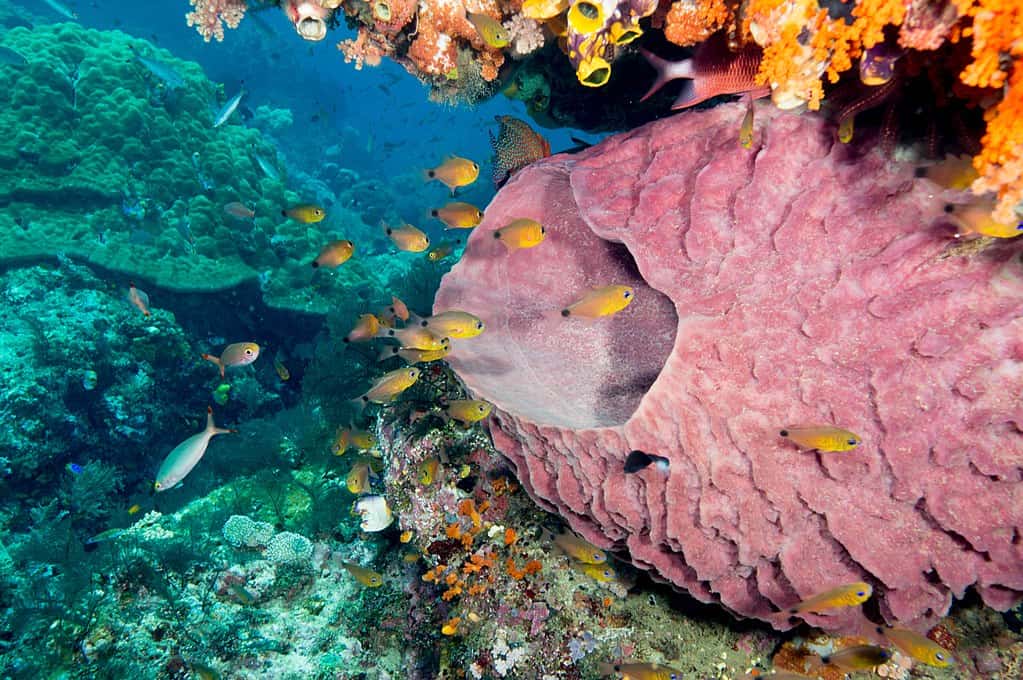
Sometimes called the “redwood of the reef,” the giant barrel sponge is among the largest and longest-lived invertebrates in coral reef ecosystems. These massive filter feeders can grow to heights of over 6 feet (1.8 meters) with diameters exceeding 4 feet (1.2 meters), creating barrel or vase-shaped structures that dominate Caribbean and Indo-Pacific reef landscapes. What’s truly remarkable about these underwater giants is their extraordinary longevity—scientists have documented specimens estimated to be more than 2,300 years old, making them some of the oldest living animals on Earth. Each day, a single giant barrel sponge can filter over 1,800 gallons (6,800 liters) of seawater, extracting bacteria and organic particles while helping maintain water clarity around coral reefs. These sponges serve as critical habitat for numerous marine organisms, with their cavernous interiors providing shelter for small fish, crustaceans, and other invertebrates. Despite their simplistic body plan—lacking organs, muscles, or nervous systems—giant barrel sponges demonstrate the extraordinary success of one of the most ancient animal designs on the planet, virtually unchanged for over 580 million years.
Conclusion

The ocean remains one of the least explored and most mysterious frontiers on our planet, and these 14 underwater giants are a testament to the awe-inspiring diversity and adaptability of marine life. From ancient sponges that have stood the test of millennia to deep-sea creatures that defy belief in both size and structure, each of these giants plays a unique role in their respective ecosystems. While some inspire fear and fascination, others contribute quietly to the health of our oceans. Together, they remind us how much there is still to learn—and protect—beneath the waves. As we continue to explore and understand these remarkable beings, it becomes ever clearer that the ocean’s depths hold not only beauty and wonder but also critical clues to the past, present, and future of life on Earth.
- 13 Wild Babies That Are Born Ready to Run - August 16, 2025
- 12 Wild Creatures That Can Regrow Entire Limbs - August 16, 2025
- How Do Whales Communicate Across Thousands of Miles? - August 16, 2025

